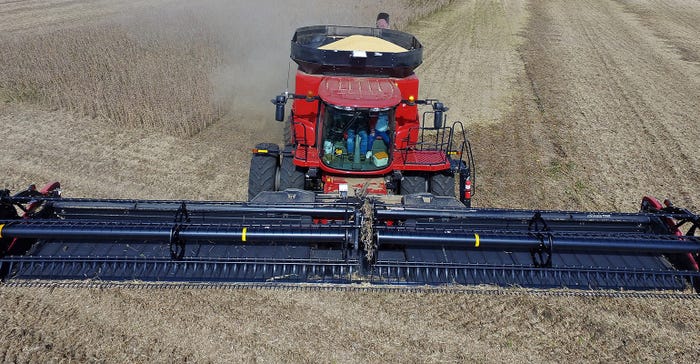April 4, 2017

By Loretta Sorensen
When he purchased his first drone about two years ago, Kevin Scott wasn’t certain it would prove to be much more than a pricey toy.
Today, Scott, of Valley Springs, S.D., is using his DJI Phantom 3 Professional drone to scout crops, obtain photos of crops in the field and examine areas where he treats weeds.
“We plant corn on 20-inch rows, which makes thorough scouting difficult,” Scott says. “Initially, I wanted to use the drone to see how effectively I was spraying weeds and whether or not I was leaving weeds in some areas.”
After taking crop pictures, Scott loads the high-resolution images on his computer and enlarges them to get a close look at crop conditions. He’s finding that the oversized images help him spot pests that he can’t see with the naked eye.
“The drone hovers over the crop to take the picture,” he says. “When I enlarge the photo, I can count the number of aphids on a plant stem to help determine the level of infestation.”
Random images of his farm captured by the drone revealed a patch of waterhemp hidden from view during his typical drive-by. Until he knew it was there, he couldn’t treat it.
Scott, who doesn’t consider himself highly experienced with technology, was able to operate the drone after studying the manual for about 10 minutes. Because drone software includes no-fly restrictions, Scott didn’t have to worry about illegally invading any air space.
“If you get close to a restricted area, the drone stops,” Scott says. “If you don’t direct it within a specific time period, it returns to the point where it was launched.”
Scott’s drone only flies up to 400 feet high. He’s careful not to use the drone outside his own farming operation, not wanting to invade the privacy of neighbors or anyone else.
Scott has invested $1,500 in his current drone, the second one he’s owned. He notes that there are plenty of drone models with features and price tags far beyond what he purchased.
“I can’t say I’ve recaptured the cost of my investment by using the drone,” Scott says. “I haven’t calculated any savings I’ve experienced in relation to the drone cost. I do know I’ve learned several things about my farming operation that are valuable to me.”

SCOUTING TOOL: Kevin Scott took this picture with his drone to learn more about field conditions. (Photo by Kevin Scott)

Scott compares drone ownership to vehicle features such as heated seats. Are they necessary to operate the vehicle? No. Are they appreciated in winter weather? Absolutely.
“I can’t put a specific value on the data I’m collecting,” Scott says. “But learning that I wasn’t cleaning my sprayer boom thoroughly enough each time I changed products helped me avoid spots of crop loss I’ve been seeing for several years. Without the drone images, I may never have figured out what was happening.”
Scott was able to confirm that his Delta Downforce planter technology was very effective when he planted soybeans in a rough field and brought the drone close behind the planter to capture video so he could view the planter as it was running.

DRONE VIEW: Kevin Scott has been pleased with the information the bird’s-eye view of the drone captures, including this photo of combining soybeans. (Photo by Kevin Scott)

“Watching the planter from behind as it was going through the field confirmed that everything was working as efficiently as I believed it was,” Scott says.
Scott expects that the use of drone technology will continue to grow, much like the precision farming technology which took time to gain favor. As drones become more common, farmers may find more practical uses, such as searching for lost livestock.

Kevin Scott (center) shows a group of visiting Chinese officials the live picture from his drone. Scott has been a longtime South Dakota Soybean leader and currently serves on the American Soybean Association board. (Photo by Julie Scott)

“One of our neighbors had some West River calves that broke out and were lying in a mature cornfield,” Scott says. “Without the drone, you couldn’t see them.”
Sorensen writes from Yankton, S.D.
You May Also Like




